Authorship
Gucker, Corey; Shaw, Nancy
Publication Date
May 2024
Nomenclature
Scabland fleabane (Erigeron bloomeri) belongs to the Asteraceae or Aster family, the Astereae tribe, Conyzinae subtribe, and the Osteocaulis section of the Erigeron genus (Nesom 2006, 2008).
Family
Asteraceae – Aster family
Genus
Erigeron
Species
bloomeri
NRCS Plant Code
ERBL (USDA NRCS 2023).
Subtaxa
The Flora of North America recognizes two varieties: bloomeri A. Gray and nudatus (A. Gray) Cronquist (Nesom 2006).
Synonyms
E.b. var. pubens D.D. Keck is a synonym for variety bloomeri and E. nudatus A. Gray is a synonym for variety nudatus (Nesom 2006; ITIS 2023).
Common Names
Scabland fleabane or daisy, Bloomer’s daisy or fleabane, feather-leaved fleabane, Waldo daisy (Applegate 1939; Hickman 1993; Nesom 2006).
Chromosome Number
2n = 18 (Cronquist 1994; Nesom 2006).
Hybridization
Intermediates between the two scabland fleabane varieties occur in California’s Del Norte and Siskiyou Counties (Nesom 2006). Hybridization is suspected, although it is rare, between scabland fleabane and desert yellow fleabane (E. linearis) (Cronquist 1947).
Distribution
Scabland fleabane occurs in Oregon, Idaho, Nevada, and California, and may occur as far north as central Washington (Cronquist 1947; Munz and Keck 1973; Hickman 1993; Nesom 2006; Hitchcock and Cronquist 2018; USDA NRCS 2023). Variety bloomeri occupies nearly the entire range described for the species (Cronquist 1947; Nesom 2006), while variety nudatus occurs in southwestern Oregon and northwestern California, primarily in the Siskiyou Mountains (Cronquist 1947; Hickman 1993; Nesom 2006).
Habitat And Plant Associations
Scabland fleabane occurs in dry, open, often rocky habitats with bunchgrasses, sagebrush (Artemisia spp.), and juniper (Juniperus spp.) (Cronquist 1947; Munz and Keck 1973; Hickman 1993; Cronquist 1994; Mansfield 2000; Lavin and Wojciechowski 2002). Variety bloomeri grows with sagebrush, mountain mahogany (Cercocarpus spp.), and in pinyon pine (Pinus spp.)-juniper, ponderosa pine (P. ponderosa), Jeffrey pine (P. jeffreyi), and western white pine (P. monticola) forests (Nesom 2006). Variety nudatus grows in chaparral and pine-fir (Abies spp.) forests (Nesom 2006).
Scabland fleabane is especially common in low sagebrush (Artemisia arbuscula) communities (Dealy 1971; Zamora and Tueller 1973; Johnson and Swanson 2005) and is a characteristic forb of the low sagebrush-dominated rangeland cover type (Shiflet 1994). Low sagebrush-dominated rangelands occur at elevations of 3,000 to 9,000 ft (900-2,700 m) in southwestern Montana, western Wyoming, northwestern Colorado, southern Idaho, northern Nevada and Utah, eastern Oregon, and northeastern California where annual precipitation averages 8 to 16 in (200-400 mm) (Shiflet 1994). In southeastern Oregon, scabland fleabane occurs in many low sagebrush/grassland (Idaho fescue [Festuca idahoensis], bluebunch wheatgrass [Pseudoroegneria spicata], Thurber’s needlegrass [Achnatherum thurberianum], and/or squirreltail [Elymus elymoides] and low sagebrush/forb vegetation associations (USDA ARS 2023).
Scabland fleabane was often described in semi-arid grasslands, shrublands (Fig. 1), and woodlands occupying low to high elevations. In a floristic survey of Crater Lake National Park, southern Oregon, scabland fleabane was one of several species occurring in both arid lowlands and high mountain areas, where conditions were often dry and low temperatures common (Applegate 1939). It was common on the upper slopes of bluebunch wheatgrass-Sandberg bluegrass (Poa secunda) communities in Three Forks Canyon in southeastern Oregon. Average annual precipitation (nearly 13 in [330 mm]) in this region was rather evenly distributed from fall through spring and the growing season was short (Dean 1960). Frequency of scabland fleabane was up to 10% in seral western juniper (J. occidentalis) woodland, but plants did not occur in climax woodlands in west-central Owyhee County, Idaho. Trees were younger (33-88 yrs) and their cover lower (22%) in seral (22%) than in climax stands (tree age 185-365 yrs, cover 47%). Shrub cover (mountain big sagebrush [Artemisia tridentata subsp. vaseyana] and antelope bitterbrush [Purshia tridentata]) was 12% in seral and less than 2% in climax stands (Burkhardt and Tisdale 1969). Scabland fleabane occurred in many vegetation communities in Pine and Mathews Canyons near Caliente, Nevada, between elevations of 5,600 to 6,700 ft (1,700-2,000 m). Constancy of scabland fleabane was 100% and frequency ranged from 4.2 to 15.5% in Utah juniper/big sagebrush/desert wheatgrass (J. osteosperma/A. tridentata/Agropyron desertorum), Utah juniper/big sagebrush/Sandberg bluegrass, Utah juniper-singleleaf pinyon (Pinus monophyla), Utah juniper-singleleaf pinyon pine/big sagebrush/pale serviceberry (Amelanchier pallida), and ponderosa pine/Gambel oak (Quercus gambelii) communities. Plants also occurred, but with lower constancy and frequency, in big sagebrush/rubber rabbitbrush (Ericameria nauseosus), Utah juniper/black sagebrush (Artemisia nova), Utah juniper/big sagebrush/squirreltail, and singleleaf pinyon/pale serviceberry-Gambel oak vegetation (Blackburn et al. 1969).
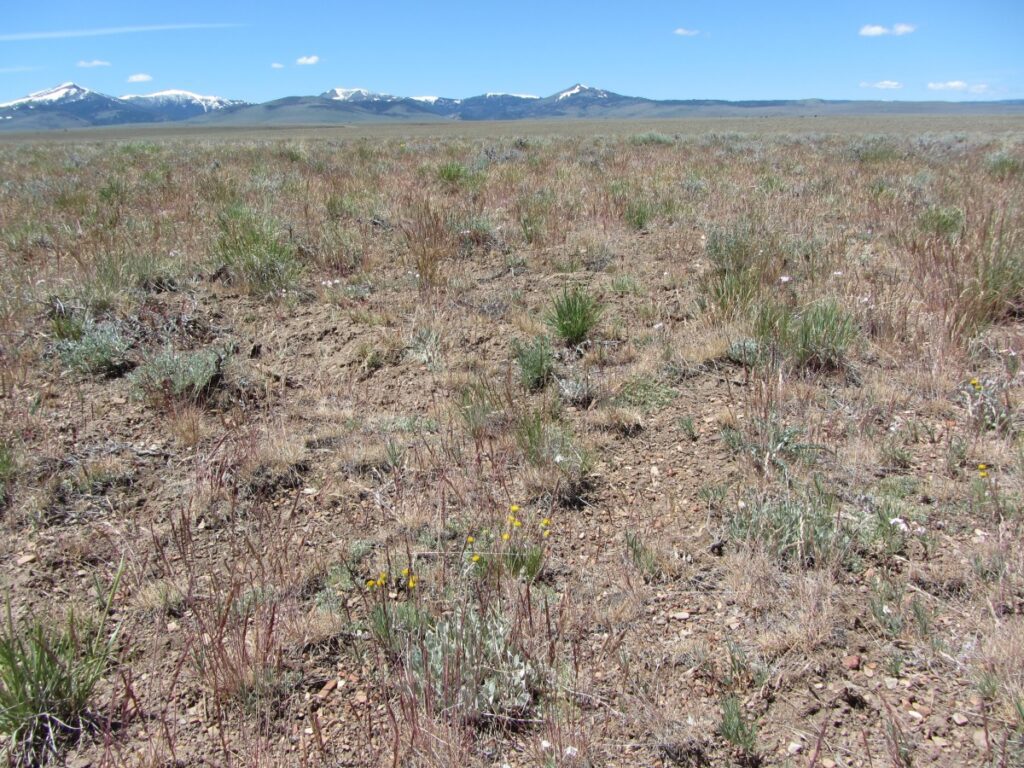
Figure 1. Scabland fleabane growing in a sagebrush-grassland in Oregon. Photo: U.S. Department of the Interior, Bureau of Land Management (USDI BLM) OR010 Seeds of Success (SOS).
Elevation
Scabland fleabane occupies habitats from 2,000 to 9,800 ft (600-3,000 m) throughout its range (Cronquist 1994; Nesom 2006). Variety bloomeri occurs at elevations of 2,600 to 9,800 ft (800-3,000 m) but is more common at elevations of 4,900 to 8,200 ft (1,500-2,500 m). Variety nudatus occurs at elevations of 2,000 to 7,500 ft (600-2,300 m) (Nesom 2006). The elevation range for the species in California is 2,000 to 7,500 ft (600-2,300 m) (Munz and Keck 1973; Hickman 1993), and on Steens Mountain in Oregon, populations are common below 5,900 (1,800 m) (Mansfield 2000).
Soils
Scabland fleabane grows in rocky or gravelly lava, talus, shale, and serpentine soils (Nesom 2006). Habitats often have dry, shallow, rocky soils from various parent materials (Munz and Keck 1973; Mansfield 2000; Hitchcock and Cronquist 2018). Surface horizons are often sandy with clay layers at depths of 3 to 8 in (7-20 cm) (J. Bates, USDA ARS, personal communication, December 2023).
Associations with serpentine soils were reported often in the reviewed literature (Hitchcock et al. 1955; Whittaker 1960; Munz and Keck 1973; Cronquist 1994; Harrison et al. 2008; Hitchcock and Cronquist 2018). Serpentine soils have high levels of magnesium and low levels of calcium and primary nutrients (Harrison et al. 2008). In an evaluation of vegetation along a moisture gradient in the Siskiyou Mountains of Oregon and California, scabland fleabane occurred only at the most xeric of low-elevation sites with serpentine soils (Whittaker 1960).
Scabland fleabane is often associated with shallow soils. It is common in the low sagebrush rangeland cover type that occupies shallow soils with an impermeable clay or bedrock layer at depths of 12 to 20 in (30-51 cm). These soils experience a range of soil moisture conditions and short growing seasons. They can be saturated for short periods in the spring and otherwise have low moisture holding capacity (Shiflet 1994). In low sagebrush communities in northern Lake County, central Oregon, where scabland fleabane was widely distributed and frequent, soils were poorly drained, shallow, stony to clay loams (Dealy 1971). In a study of vegetation in the Blue and Ochoco Mountains of Oregon, scabland fleabane grew in Idaho fescue and bluebunch wheatgrass communities with erosion pavement or bedrock at 5 to 20 in (13-51 cm) deep. It also occurred in low sagebrush/bluebunch wheatgrass communities on basalt and andesite. Soils were gravelly clay loams with bedrock at 8 to 18 in (20-46 cm) deep and experienced excess water in the spring and little to none during summer drought conditions (Johnson and Swanson 2005). Soils were similarly shallow, fine-textured, and poorly structured in low sagebrush (A. arbuscula) scabland vegetation in central Oregon where a clayey and gravelly and/or an indurated layer restricted rooting. This vegetation experienced a continental climate, average annual precipitation of 15 in (381 mm), and growing season of 75 to 85 days with killing frosts possible in any month (Dealy and Geist 1978).
On Grizzly Peak Plateau (5,770 ft [1,760 m]) in Jackson County, Oregon, scabland fleabane grew with other forbs on thin, rocky to lithic, basaltic andesite soils (Riser et al. 2007) and in west-central Owyhee County, Idaho, it grew in gravelly silt loam soils supporting seral western juniper stands, but not in climax stands. Soils in the climax woodlands were shallow with an abundance of rocky outcrops. Soils were deeper with few to no rocky outcrops in seral woodlands (Burkhardt and Tisdale 1969).
Description
Scabland fleabane is a taprooted perennial with a multi and short-branched caudex (Hickman 1993; Nesom 2006; Hitchcock and Cronquist 2018). It has been called a subshrub in alpine areas of California’s Sierra Nevada mountains (Rundel 2011). Plants are cespitose and low-statured (1.6 to 6 in [4-15 cm] tall) (Nesom 2006; Hitchcock and Cronquist 2018). The numerous stems are erect and usually thickened, hard, and shiny at the base, but not thickened as much or as consistently as desert yellow fleabane (Erigeron linearis) (Cronquist 1947, 1994). Herbage ranges from glabrous (Fig. 2) to densely white strigose (Fig. 3) with fine, mostly appressed eglandular hairs (Cronquist 1947; Munz and Keck 1973; Nesom 2006).
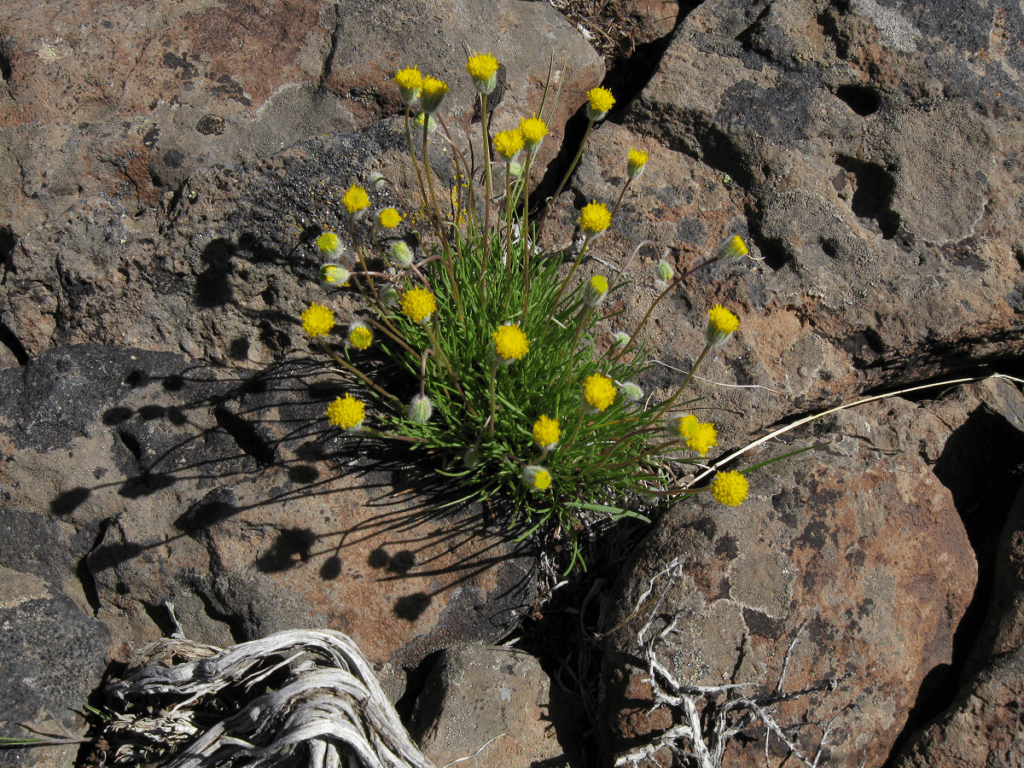
Figure 2. Scabland fleabane plant with glabrous linear leaves growing between rocks in California. Photo: USDI BLM CA370 SOS.
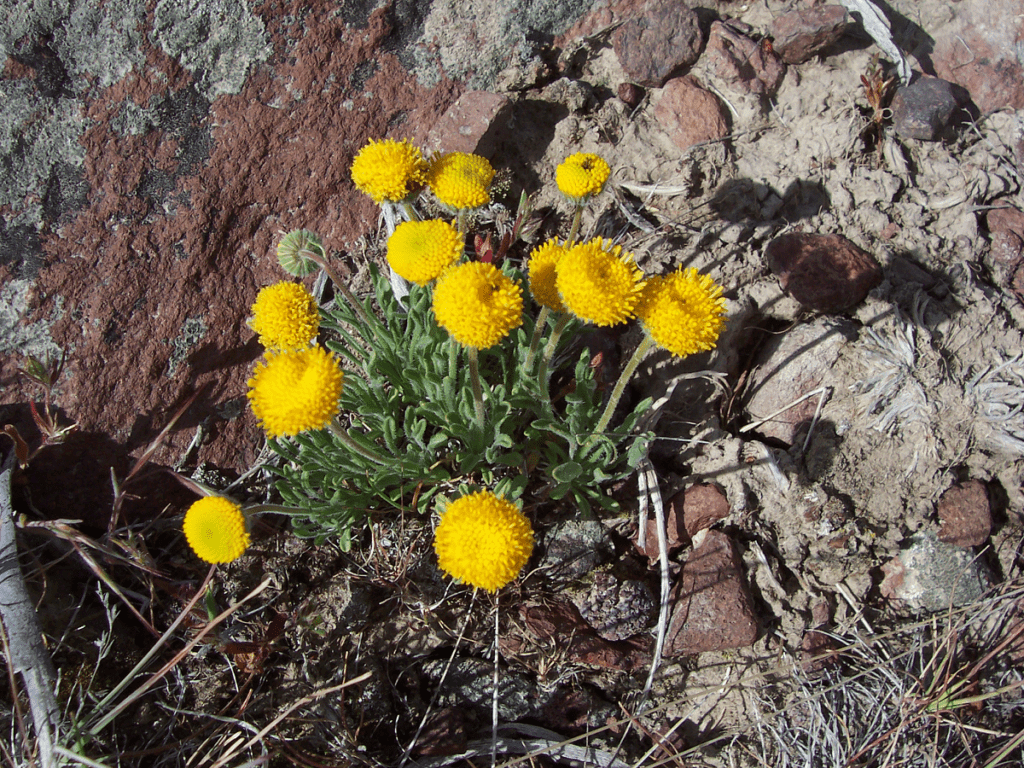
Figure 3. Scabland fleabane with fuzzy herbage growing in rocky soils in Idaho. Photo: USDI BLM ID075 SOS.
Leaves are alternate and mostly to entirely basal (U.S. Department of Agriculture 1937; Nesom 2006). They are linear, 0.8 to 3 in (2-7 cm) long, and 1 to 3 mm wide (Munz and Keck 1973; Hickman 1993; Mansfield 2000; Hitchcock and Cronquist 2018). Stem leaves, if present, are much reduced and restricted to the lower parts of the stem (Hickman 1993; Cronquist 1994). Scabland fleabane produces solitary flower heads measuring 0.3 to 0.8 in (0.7-2 cm) in diameter (Hickman 1993; Cronquist 1994; Nesom 2006; Hitchcock and Cronquist 2018). Heads are turbinate or nearly hemispheric and entirely comprised of bisexual, fertile, bright yellow disk florets (Cronquist 1947, 1994; Mansfield 2000; Nesom 2006). Involucres are 0.2 to 0.4 in (0.5-1 cm) tall (Fig. 4) and range from strigose to villous and minutely glandular to eglandular (Munz and Keck 1973; Nesom 2006). Phyllaries are broad and more or less equal in 2 to 3 series (Munz and Keck 1973; Hickman 1993; Nesom 2006). Plants produce achenes, hereafter referred to as seeds (Cronquist 1994). They are two-nerved, 3 to 4 mm long, glabrous below, and short hairy above (Cronquist 1947; Nesom 2006). Seeds have pappi with outer setae and 25 to 40 inner bristles (Munz and Keck 1973; Cronquist 1994; Nesom 2006; Hitchcock and Cronquist 2018).
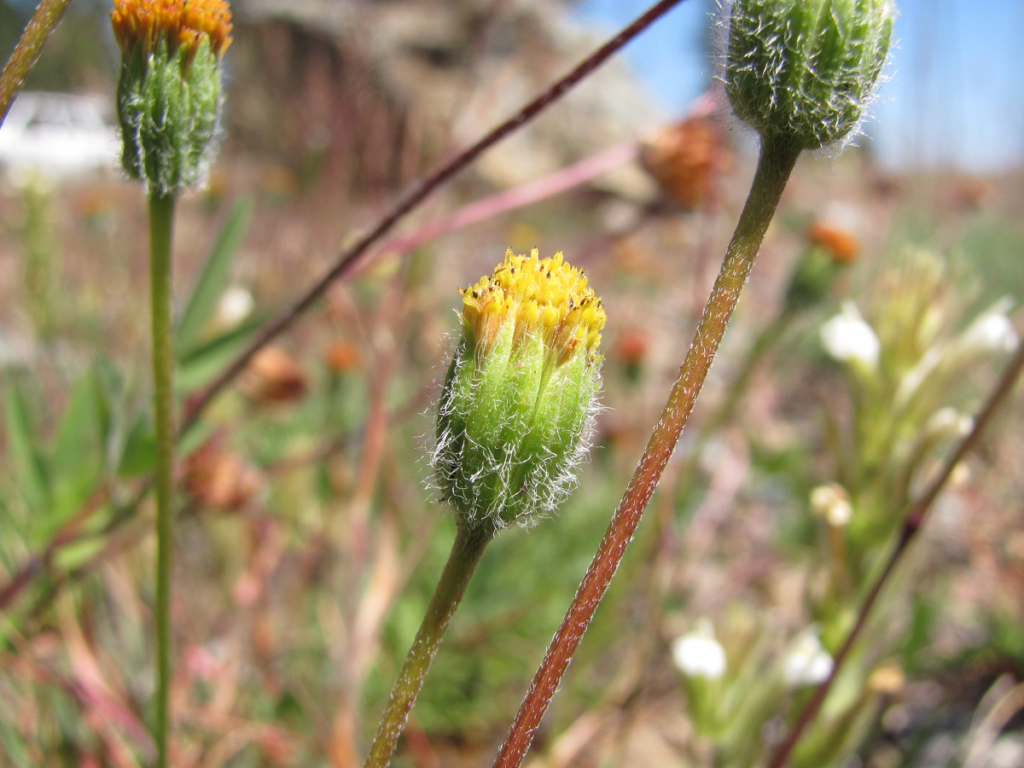
Figure 4. Involucre and flower bud of scabland fleabane growing in Oregon. Photo: USDI BLM OR110 SOS.
The herbage of variety bloomeri is largely strigose. Phyllaries are densely strigose to hirsute or hirsute-villous and minutely glandular (Hickman 1993; Nesom 2006). The herbage of variety nudatus is glabrous to sparsely strigose. Phyllaries are glabrous and sparsely minutely glandular or eglandular (Munz and Keck 1973; Hickman 1993; Nesom 2006).
Reproduction
Scabland fleabane reproduces by seed (Fig. 5). Production of seed is likely improved with pollination (like other Erigeron spp.), but specifics about scabland fleabane reproduction were lacking in the available literature. Plants flower primarily from May to July, but dates as late as August were reported for variety bloomeri and September for variety nudatus (Munz and Keck 1973; Nesom 2006).
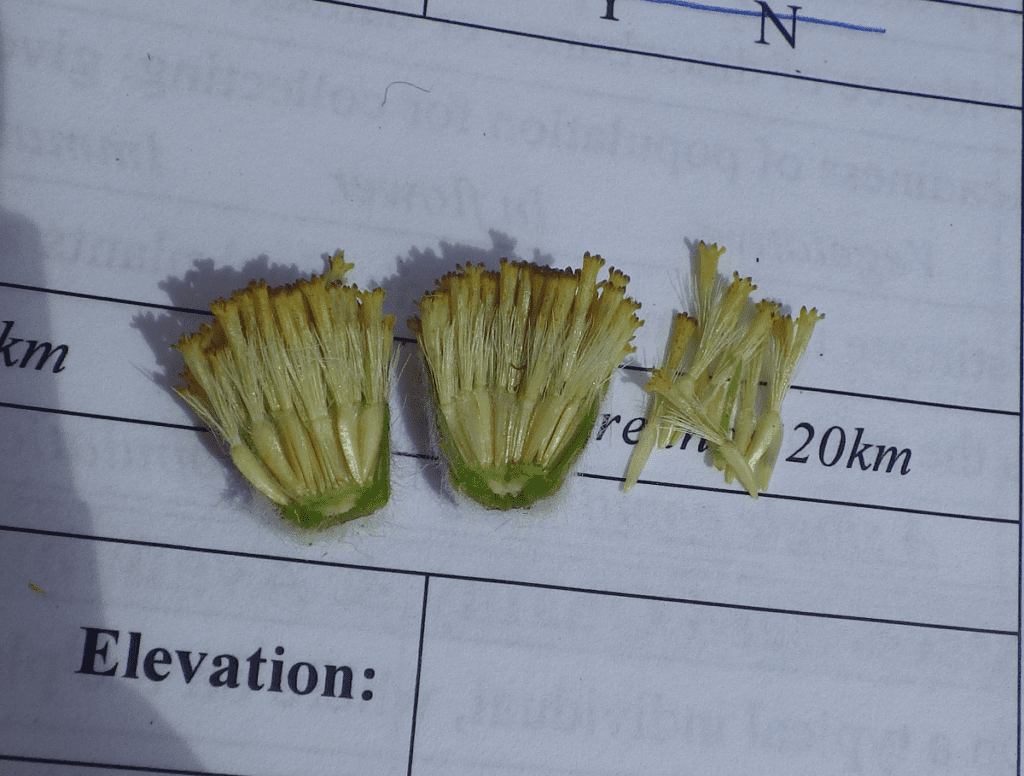
Figure 5. Cross-section of seedhead shows individual immature seeds with pappi. Photo: USDI BLM NV030 SOS.
Ecology
While the Erigeron genus is considered disturbance tolerant with plants increasing with heavy grazing (U.S. Department of Agriculture 1937) and relatively unaffected by fire (Riegel et al. 2006), fire studies report that the scabland fleabane response to fire can be variable (Bates et al. 2011, 2022).
Both unchanged abundance and severe decreases in abundance were reported for scabland fleabane following late summer or fall prescribed fires (Bates et al. 2011, 2022). In late seral Wyoming big sagebrush (Artemisia tridentata subsp. wyomingensis) near Burns, Oregon, scabland fleabane cover was 80% lower on burned than unburned plots in the first post-fire year after a fall prescribed fire and August wildfire in the area (Bates et al. 2011). Reduced cover persisted for at least 3 years after fire. There were no statistical differences in scabland fleabane cover or density in burned and unburned low sagebrush 1 to 5 years after the prescribed fire (Bates et al. 2022).
Seed And Seedling Ecology
The limited studies available suggest that scabland fleabane produces a short-lived seed bank (Nunes and Byrne 2022) and that seedling emergence and survival are limited (Agneray et al. 2022).
A study determined the composition of a persistent seed bank at the western-most edge of sagebrush ecosystems in the Great Basin in southeastern Oregon (Nunes and Byrne 2022). The timing (mid-May) of soil sample collections (36 soil cores of 2 × 2 in [5 × 5 cm]) was selected to uncover dormant seeds produced in 2018 or earlier that did not germinate in fall 2018 or early spring 2019. Scabland fleabane occurred in the aboveground vegetation in the low sagebrush-dominated study area but not in the seed bank. The majority of seedlings emerging from collected soil samples were nonnative annual grasses (58%) and forbs (31%) (Nunes and Byrne 2022).
Seed and seedling relationships were evaluated for Erigeron spp. (scabland, desert yellow, rayless shaggy [E. aphanactis], and threadleaf [E. filifolius] fleabane) in greenhouse studies (Agneray et al. 2022). Using seed collected throughout the western Great Basin, (7.5-15.3 in [190-388 mm] annual ppt.; 4,183-7,874 ft [1,275-2,400 m]). Erigeron had some of the earliest emergence, but survival was among the lowest (mean: 7%, range: 0-23%) of all species and forms evaluated. Erigeron seed mass was positively associated with seedling survival. High root mass ratio (RMR = root mass/total mass) and low specific root length (SRL = total root length in m/root mass in g; coarse roots) were associated with increased seedling survival of Erigeron. Erigeron seed from sites with higher mean temperatures had the highest survival in competitive environments (1 native seed with 3 cheatgrass [Bromus tectorum] seeds in 0.16 L pots). For the competitive experiments, pots were kept in a greenhouse with temperatures that mimicked the transition from cooler to warmer seasons that are typical of the Great Basin environment. Media in the pots was a 10:25:65 mix of perlite: sand: coarse-textured field soil collected in Dayton, Nevada (Agneray et al. 2022).
Wildlife And Livestock Use
Erigeron species are considered more palatable to sheep and goats than to cattle. They are not eaten by horses (U.S. Department of Agriculture 1937). They are important components of greater sage-grouse (Centrocercus urophasianus) habitats in the Great Basin (Lambert 2005) and are utilized as hosts or for feeding by northern checkerspot (Chlosyne palla) and field crescent (Phyciodes pulchella) butterflies (James and Nunnallee 2011).
In a study of mule deer (Odocoileus hemionus) range in northern Lake County, central Oregon, low sagebrush communities where scabland fleabane was frequent were utilized some. Forbs in the community provided valuable spring and early summer mule deer forage (Dealy 1971).
Ethnobotany
The common name for the Erigeron genus, fleabane, suggests its use as a flea repellent. Early reporting by the U.S. Department of Agriculture (1937) notes that when burned, some fleabane species repel insects.
Horticulture
The low stature, bright yellow flowers, and dry rocky soil tolerance suggest that scabland fleabane would do well in rock gardens. Plants require excellent drainage and do best in mostly full sun (Hickman 1993).
Revegetation Use
Use of scabland fleabane in revegetation was not reported in the available literature, but it attracts pollinators (Ogle et al. 2012) and could be useful in pollinator habitat restoration efforts.
Developing A Seed Supply
For restoration to be successful, the right seed needs to be planted in the right place at the right time. Coordinated planning and cooperation is required among all partners to select appropriate species and seed sources; these are determined by site conditions, current or projected revegetation requirements and goals (PCA 2015), and consultation with land managers and stakeholders.
Developing a seed supply begins with seed collection from native stands. Collected seed is distributed for restoration or production of nursery stock. Increase in agricultural seed fields may be required to provide a supply of seed (PCA 2015). Production of nursery stock requires less seed than large-scale seeding operations. Regardless of the size and complexity of any revegetation effort, seed certification is essential for tracking seed origin from collection through use (UCIA 2015).
Seed Sourcing
Because empirical seed zones are not currently available for scabland fleabane, generalized provisional seed zones developed by Bower et al. (2014) may be used to select and deploy seed sources. These provisional seed zones identify areas of climatic similarity with comparable winter minimum temperature and aridity (annual heat to moisture index). In Figure 6, Omernik Level III Ecoregions (Omernik 1987) overlay the provisional seed zones to identify climatically similar but ecologically different areas. For site-specific disturbance regimes and restoration objectives, seed collection locations within a seed zone and ecoregion may be further limited by elevation, soil type, or other factors.
The Western Wildland Environmental Threat Assessment Center’s (USDA FS WWETAC 2017) Threat and Resource Mapping (TRM) Seed Zone application provides links to interactive mapping features useful for seed collection and deployment planning. The Climate Smart Restoration Tool (Richardson et al. 2020) can also guide revegetation planning, seed collection, and seed deployment, particularly when addressing climate change considerations.
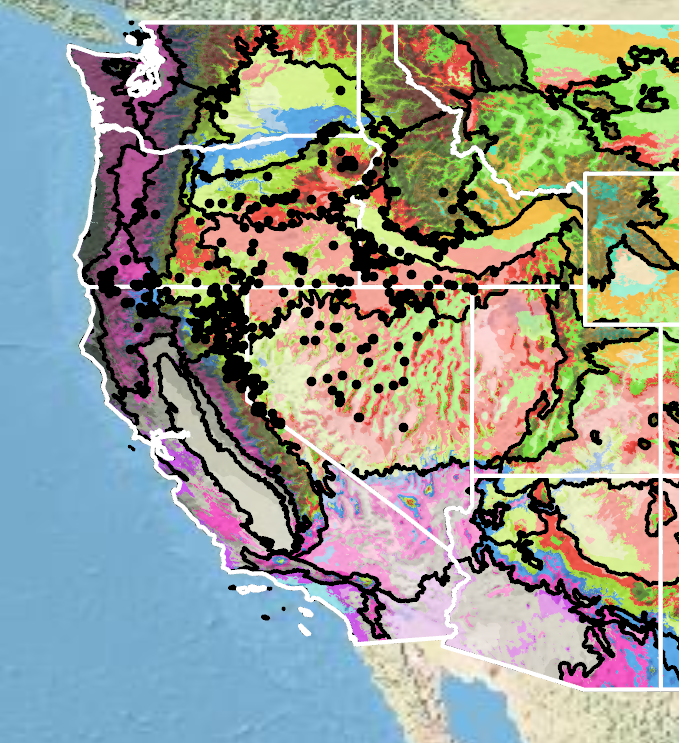
Figure 6. Distribution of scabland fleabane (black circles) based on geo-referenced herbarium specimens and observational data from 1868-2023 (CPNWH 2023; SEINet 2023; USDI USGS 2023). Generalized provisional seed zones (colored regions) (Bower et al. 2014) are overlain by Omernik Level III Ecoregions (black outlines) (Omernik 1987; USDI EPA 2018). Interactive maps, legends, and a mobile app are available (USDA FS WWETAC 2017; www.fs.fed.us/wwetac/threat-map/TRMSeedZoneMapper2.php?). Map prepared by S. Barga, USDA Forest Service, RMRS.
Releases
As of 2023, there were no scabland fleabane germplasm releases.
Wildland Seed Collection
Scabland fleabane produces dandelion-like seedheads (Fig. 7) that can be collected by hand stripping the seeds from the head or clipping the entire head. The fluffy pappus (Fig. 8) suggests that seed disperses soon after the seed head opens fully, but details about seed retention, collection methods, and notes about collection timing were generally lacking in the available literature.
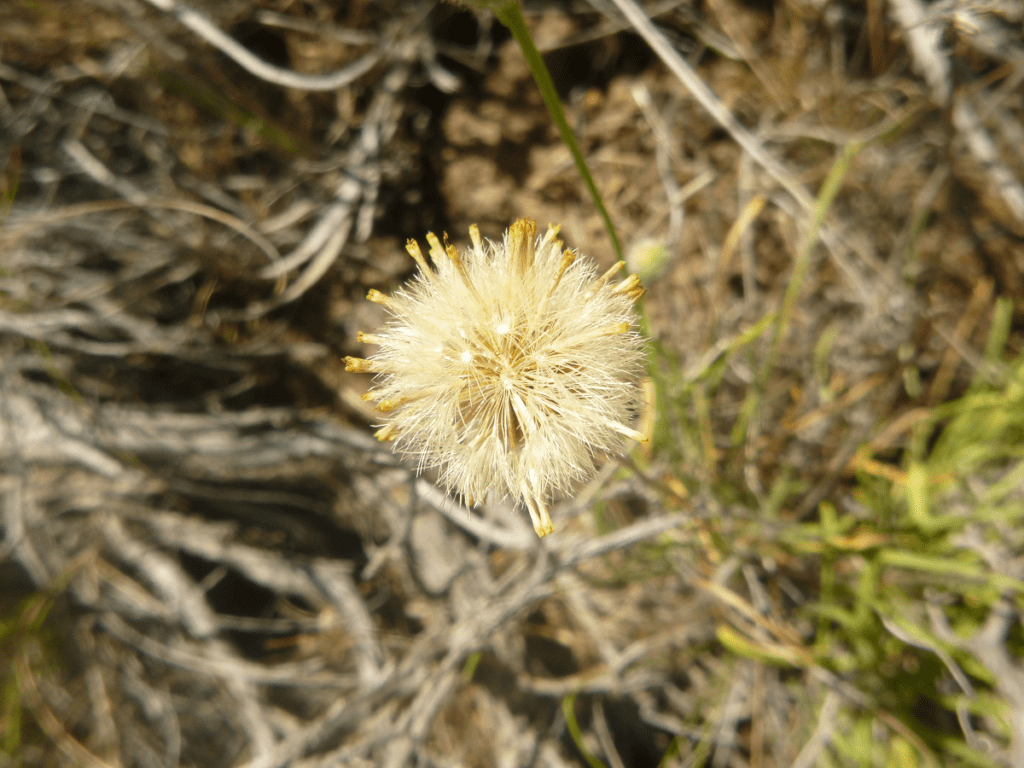
Figure 7. Fully open, nearly mature scabland fleabane seed head. Photo: USDI BLM 0R930 SOS.
Wildland Seed Certification
Verification of species and tracking of geographic source is necessary whether wildland seed is collected for immediate project use or as stock seed for cultivated increase. This official Source Identification process can be accomplished by following procedures established by the Association of Official Seed Certifying Agencies (AOSCA) Pre-Variety Germplasm Program (UCIA 2015; Young et al. 2020). Wildland seed collectors should become acquainted with state certification agency procedures, regulations, and deadlines in the states where they collect.
If wildland-collected seed is to be sold for direct use in ecological restoration projects, collectors must apply for Source-Identified certification prior to making collections. Pre-collection applications, site inspections, and species and seed amount verification are handled by the AOSCA member state agency where seed collections will be made (see listings at AOSCA.org).
If wildland seed collected by a grower or private collector is to be used as stock seed for planting cultivated seed fields or for nursery propagation (See Agricultural Seed Field Certification section), detailed information regarding the collection site and collecting procedures must be provided when applying for certification. Photos and herbarium specimens may be required. Germplasm accessions acquired within established protocols of recognized public agencies, however, are normally eligible to enter the certification process as stock seed without routine certification agency site inspections. For contract grow-outs, however, this collection site information must be provided to the grower to enable certification.
Collection Timing
The USDI Bureau of Land Management, Seeds of Success collection crews provided the following notes regarding 11 collections of scabland fleabane seed (USDI BLM SOS 2020). Harvests were made in 6 years between 2002 and 2017. The earliest collection was made on June 9, 2015, in Lassen County, California, at an elevation of 5,666 ft (1,727 m) and on the same date in 2016 in Lake County, Oregon, at an elevation of 5,262 ft (1,604 m). The latest collection was made on July 27, 2010, in Malheur County, Oregon, at an elevation of 5,011 ft (1,527 m). In the single year (2015) with the most collections made (4), the earliest was on June 9 in Lassen County, California (5,666 ft [1,727 m]), and the latest was June 25 in Harney County, Oregon (4,297 ft [1,310 m]). At two sites, seed collectors returned 3 or 4 days later to make a second harvest (USDI BLM SOS 2020).
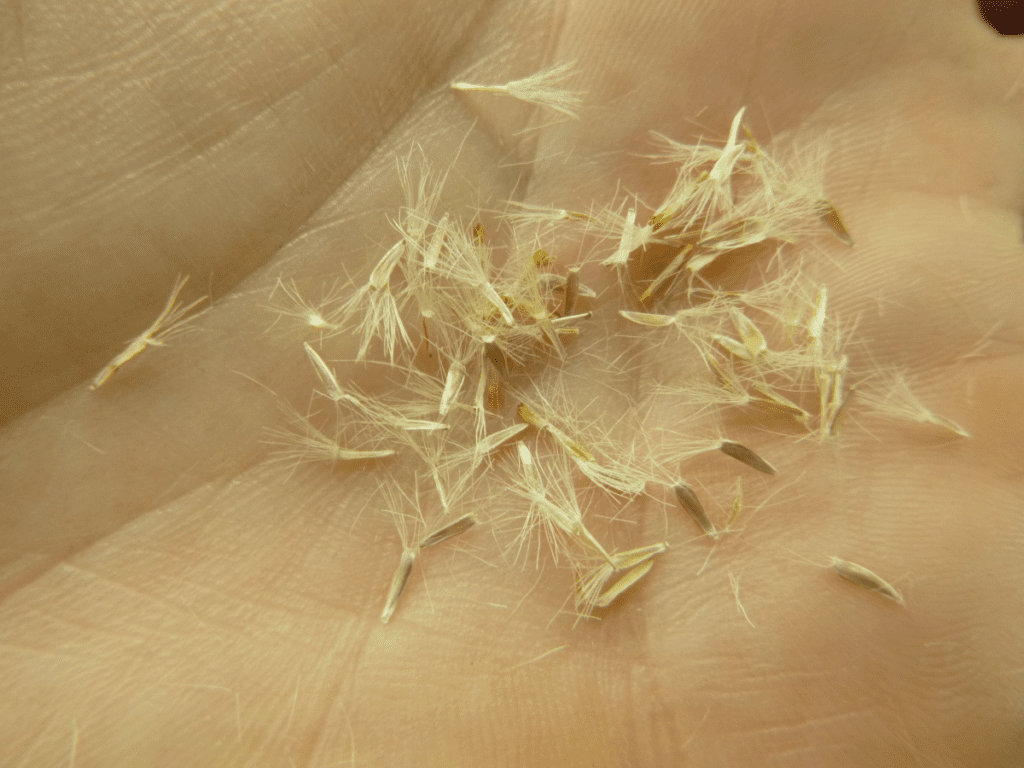
Figure 8. Small handful of scabland fleabane seeds with pappi attached. Photo: USDI BLM OR931 SOS.
Collection Methods
Several collection guidelines and methods should be followed to maximize the genetic diversity of wildland collections: 1) collect seed from a minimum of 50 randomly selected plants; 2) collect from widely separated individuals throughout a population without favoring the most robust or avoiding small stature plants; and 3) collect from all microsites including habitat edges (Basey et al. 2015). General collecting recommendations and guidelines are provided in online manuals (e.g., ENSCONET 2009; USDI BLM SOS 2023).
It is critical that wildland seed collection does not impact the sustainability of native plant populations. Collectors should take no more than 20% of the viable seed available at the time of harvest (USDI BLM SOS 2023). Additionally, care must be taken to avoid the inadvertent collection of weedy species, particularly those that produce seeds similar in shape and size to those of scabland fleabane.
Post-Collection Management
Although not specifically discussed in the literature, post-collection management of scabland fleabane seed should be dried thoroughly before storing and if insects are suspected, insect strips can be used or seed can be stored at low temperatures to prevent substantial loss to insect damage.
Seed Cleaning
Specific methods for cleaning scabland fleabane seed were lacking in the reviewed literature. See other Erigeron species reviews at westernforbs.org for cleaning procedures that could be adapted for scabland fleabane.
Seed Storage
Scabland fleabane seed is orthodox. After 45 days of storage at 15% relative humidity and -4 °F (-20 °C), seed viability of scabland fleabane was 84%. The initial viability was unknown (SER, INSR, RBGK 2023).
Seed Testing
Moore (1985) provided the following unofficial tetrazolium (TZ) test of scabland fleabane viability. Seed was moistened for 6 to 8 hours, cut longitudinally with a complete cut through the midsection of the distal half, and the distal end of the seed removed. The cut seed was stained for 6 to 24 hours and considered viable if stained completely or all but the distal third was stained (Moore 1985).
There is no AOSA rule for testing germination of scabland fleabane seed, but there is one for aspen fleabane, which may provide a good starting point. The amount of seed needed for purity testing is also provided for aspen fleabane (AOSA 2016).
Germination Biology
Seed may not require a special pretreatment to germinate, but Young and Young (1986) indicate that Erigeron spp. require light to germinate. Laboratory testing of scabland fleabane reported 70% germination after 35 days for seed on 1% agar exposed to an 8:16 light-dark cycle at a constant 68 °F (20 °C) (SER, INSR, RBGK 2023). Germination increased to 85% with more time (77 days), even if seeds were exposed to cooler temperatures 59 °F (15 °C).
Wildland Seed Yield And Quality
Post-cleaning seed yield and quality of seed lots collected in the Intermountain region are provided in Table 1 (USDA FS BSE 2017). The results indicate that scabland fleabane seed can generally be cleaned to high levels of purity and seed fill and that viability of fresh seed is generally high.
Table 1. Seed yield and quality of scabland fleabane seed lots collected in the Intermountain region, cleaned by the Bend Seed Extractory, and tested by the Oregon State Seed Laboratory or the USDA Forest Service National Seed Laboratory (USDA FS BSE 2017).
| Seed lot characteristic | Mean | Range | Samples (no.) |
| Bulk weight (lbs) | 0.25 | 0.08-0.6 | 10 |
| Clean weight (lbs) | 0.04 | 0.003-0.12 | 10 |
| Clean-out ratio | 0.17 | 0.017-0.3 | 10 |
| Purity (%) | 95 | 86-99 | 10 |
| Fill (%)¹ | 92 | 86-99 | 10 |
| Viability (%)² | 94 | 88-97 | 9 |
| Seeds/lb | 647,998 | 561,386-827,000 | 10 |
| Pure live seeds/lb | 561,511 | 449,558-672,865 | 9 |
¹ 100 seed X-ray test
² Tetrazolium chloride test
Marketing Standards
Acceptable seed purity, viability, and germination specifications vary with revegetation plans. Purity needs are highest for precision seeding equipment used in nurseries, while some rangeland seeding equipment handles less clean seed quite well.
Agricultural Seed Production
There were no reports of growing scabland fleabane for seed production. See other reviews of Erigeron species at WesternForbs.org for information that could be used to inform experimental research into this species.
Agricultural Seed Certification
In order to minimize genetic changes in specific accessions of native species when increased in cultivated fields, it is essential to track the geographic source and prevent inadvertent hybridization or selection pressure. This is accomplished by following third party seed certification protocols for Pre-Variety Germplasm (PVG) as established by the Association of Official Seed Certification Agencies (AOSCA). AOSCA members in the U.S., Canada, and other countries administer PVG requirements and standards that track the source and generation of planting stock. Field and cleaning facility inspections then monitor stand establishment, proper isolation distances, control of prohibited weeds, seed harvesting, cleaning, sampling, testing, and labeling for commercial sales (UCIA 2015; Young et al. 2020).
Seed growers apply for certification of their production fields prior to planting and plant only certified stock seed of an allowed generation (usually less than four). The systematic and sequential tracking through the certification process requires preplanning, knowing state regulations and deadlines, and is most smoothly navigated by working closely with state certification agency personnel. See the Wildland Seed Certification section for more information on stock seed sourcing.
Nursery Practice
There were no protocols or procedures described for growing scabland fleabane nursery stock. See other reviews of Erigeron species at WesternForbs.org for information that could be used to inform experimental research into this species.
Wildland Seeding And Planting
Although there were no studies in the available literature on use of scabland fleabane in revegetation, Erigeron species are considered good for pollinators (Ogle et al. 2012). They also have slow growth rates suggesting they should be seeded separately from rapidly growing species. The recommended full seeding rate is 1 to 4 lbs/ac (1.1-4.5 kg/ha), which would need to be adjusted according to the desired rate in the seed mix (Ogle et al. 2012).
Acknowledgements
Funding for Western Forbs: Biology, Ecology, and Use in Restoration was provided by the USDI BLM Great Basin Native Plant Materials Ecoregional Program through the Great Basin Fire Science Exchange. Great thanks to the chapter reviewer: Jonathan Bates, U.S. Department of Agriculture (USDA), Agricultural Research Service and Sarah Barga, USDA, Forest Service, Rocky Mountain Research Station.
This research was supported in part by the USDA Forest Service, Rocky Mountain Research Station. The findings and conclusions in this publication are those of the authors and should not be construed to represent any official USDA or U.S. Government determination or policy.
Literature Cited
Agneray, A.C.; Parchman, T.L.; Leger, E.A. 2022. Phenotypes and environment predict seedling survival for seven co-occurring Great Basin plant taxa growing with invasive grass. Ecology and Evolution. 12(5): e8870.
Applegate, E.I. 1939. Plants of Crater Lake National Park. The American Midland Naturalist. 22(2): 225-314.
Association of Official Seed Analysts [AOSA]. 2016. AOSA rules for testing seeds. Vol. 1. Principles and procedures. Washington, DC: Association of Official Seed Analysts.
Basey, A.C.; Fant, J.B.; Kramer, A.T. 2015. Producing native plant materials for restoration: 10 rules to collect and maintain genetic diversity. Native Plants Journal. 16(1): 37-53.
Bates, J.D.; Davies, K.W. 2022. Early succession following prescribed fire in low sagebrush (Artemisia arbuscula var. arbuscula) steppe. 82(1): 50-66.
Bates, J.D.; Rhodes, E.C.; Davies, K. 2011. Impacts of fire on sage-grouse habitat and diet resources. Natural Resources and Environmental Issues. 17(5): 1-17.
Blackburn, W.H.; Tueller, P.T.; Eckert, R.E. 1969. Vegetation and soils of the Pine Canyon and Mathews Canyon watersheds. R-46. Reno, NV: University of Nevada, Agricultural Experiment Station. 109 p.
Bower, A.D.; St. Clair, J.B.; Erickson, V. 2014. Generalized provisional seed zones for native plants. Ecological Applications. 24(5): 913-919.
Burkhardt, J.W.; Tisdale, E.W. 1969. Nature and successional status of western juniper vegetation in Idaho. Journal of Range Management. 22(4): 264-270.
Consortium of Pacific Northwest Herbaria [CPNWH]. 2023. Seattle, WA: University of Washington Herbarium, Burke Museum of Natural History and Culture. http://www.pnwherbaria.org/index.php
Cronquist, A. 1947. Systematic treatment of the species: [Erigeron peregrinus–Erigeron nanus]. Brittonia 6(2): 142-192.
Cronquist, A. 1994. Volume five: Asterales. In: Cronquist, A.; Holmgren, A.H.; Holmgren, N.H.; Reveal, J.L.; Holmgren, P.K., eds. Intermountain flora: Vascular plants of the Intermountain West, U.S.A. Bronx, NY: The New York Botanic Garden. 496 p.
Dealy, J. E. 1971. Habitat characteristics of the Silver Lake mule deer range. Res. Pap. PNW-125. Portland, OR: U.S. Department of Agriculture, Forest Service, Pacific Northwest Forest and Range Experiment Station. 99 p.
Dealy, J.E.; Geist, J.M. 1978. Conflicting vegetational indicators on some central Oregon scablands. Journal of Range Management. 31(1): 56-59.
Dean, M.L. 1960. A taxonomic and ecologic study of the vascular plants of a section of the Owyhee River Canyon in Oregon. Corvallis, OR: Oregon State College. Thesis. 147 p.
European Native Seed Conservation Network [ENSCONET]. 2009. ENSCONET seed collecting manual for wild species. Edition 1: 32 p.
Harrison, S.; Viers, J.H.; Thorne, J.H.; Grace, J.B. 2008. Favorable environments and the persistence of naturally rare species. Conservation Letters. 1: 65-74.
Hickman, J.C., ed. 1993. The Jepson manual: Higher plants of California. Berkeley, CA: University of California Press. 1400 p.
Hitchcock, C.L.; Cronquist, A. 2018. Flora of the Pacific Northwest: An illustrated manual. Second Ed. Giblin, D.E.; Legler, B.S.; Zika, P.F.; Olmstead, R.G., eds. Seattle, WA: University of Washington Press. 882 p.
Hitchcock, C.L.; Cronquist, A.; Ownbey, M.; Thompson, J.W. 1955. Vascular plants of the Pacific Northwest. Part 3: Saxifragaceae to Ericaceae. Seattle, WA: University of Washington Press. 614 p.
ITIS Database. 2022. Integrated Taxonomic Information System. Available: http://www.itis.gov/index.html
James, D.G.; Nunnallee, D. 2011. Life histories of Cascadia butterflies. Corvallis, OR: Oregon State University Press. 447 p.
Johnson, C.G.; Swanson, D.K. 2005. Bunchgrass plant communities of the Blue and Ochoco Mountains: A guide for managers. Gen. Tech. Rep. PNW-GTR-641. Portland, OR: U.S. Department of Agriculture, Forest Service, Pacific Northwest Research Station. 119 p.
Lambert, S. 2005. Guidebook to the seeds of native and non-native grasses, forbs and shrubs of the Great Basin. Boise, ID: U.S. Department of the Interior, Bureau of Land Management, Idaho State Office. 136 p.
Lavin, M.; Wojciechowski, M.F. 2002. Vascular flora of the Sweetwater Mountains of California and Nevada. 24 p. http://bristleconecnps.org/native_plants/checklists/SweetwatersChecklistJun2002.pdf [Accessed 2023 October 10].
Mansfield, D.H. 2000. Flora of Steens Mountain. Corvallis, OR: Oregon State University Press. 410 p.
Moore, R.P. 1985. Handbook on tetrazolium testing. Zurich, Switzerland: International Seed Testing Association. 99 p.
Munz, P.A.; Keck, D.D. 1973. A California flora and supplement. Berkeley, CA: University of California Press. 1905 p.
Nesom, G.L. 2006. 186. Erigeron. In: Flora of North America Editorial Committee, ed. Flora of North America North of Mexico. Volume 20 Magnoliophyta: Asteridae, part 7: Asteraceae, part 2 Asterales, part 2 (Aster order). New York, NY: Oxford University Press: 256-348.
Nesom, G.L. 2008. Classification of subtribe Conyzinae (Asteraceae: Astereae). Lundellia. 11(8): 8-38.
Nunes, A.M.; Byrne, K.M. 2022. Drought and shrub cover differentially affect seed bank composition within two sagebrush steppe communities. Journal of Arid Environments. 202: 104752.
Ogle, D., Tilley, D., St. John, L., Stannard, M., and Holzworth, L. 2014. Conservation plant species for the Intermountain West. Plant Materials Technical Note 24. Boise, ID: U.S. Department of Agriculture, Natural Resources Conservation Service. 72 p.
Plant Conservation Alliance [PCA]. 2015. National seed strategy for rehabilitation and restoration 2015-2020. Washington, DC: U.S. Department of the Interior, Bureau of Land Management. 52 p.
Richardson, B.; Kilkenny, F.; St. Clair, B.; Stevenson-Molnar, N. 2020. Climate Smart Restoration Tool. https://climaterestorationtool.org/csrt/
Riegel, G.M.; Miller, R.F.; Skinner, C.N.; Smith, S.E. 2006. Northeastern Plateaus bioregion. In: Sugihara, N.G.; van Wagtendonk, J.W.; Shaffer, K.E.; Fites-Kaufman, J.; Thode, A., eds. Fire in California’s ecosystems. Berkeley, CA: University of California Press: 225-263.
Riser, J.P.; McClaran, M.P.; Nafus, A.M.; Adams, J.D.; Tiehm, A.; Draper, T.M.; Duncan, J.T.; Sondenaa, A.C.; McClarin, B.A.; Gutierrez, R.; Brennan, K.; Brasher, J.W.; Enloe, S.F. 2007. Noteworthy collections. Madrono. 54(2): 203-211.
Rundel, P.W. 2011. The diversity and biogeography of the alpine flora of the Sierra Nevada, California. Madrono. 58(3): 153-184.
SEINet-Regional Networks of North American Herbaria Steering Committee [SEINet]. 2023. SEINet Regional Networks of North American Herbaria. https://Symbiota.org/docs/seinet
Shiflet, T.N. 1994. Rangeland cover types of the United States. Denver, CO: Society for Range Management. 152 p.
Society for Ecological Restoration; International Network for Seed Based Restoration; Royal Botanic Gardens [SER, INSR, RBGK]. 2023. Seed Information Database (SID). Available from: https://ser-sid.org/
U.S. Department of Agriculture, Agricultural Research Service [USDA ARS]. 2023. Plant associations for eastern Oregon. Burns, OR: Eastern Oregon Agricultural Research Center. Data on file.
USDA Forest Service, Bend Seed Extractory [USDA FS BSE]. 2017. Nursery Management Information System Version 4.1.11. Local Source Report 34-Source Received. Bend, OR: U.S. Department of Agriculture, Forest Service, Bend Seed Extractory.
USDA Forest Service, Western Wildland Environmental Threat Assessment Center [USFS WWETAC]. 2017. TRM Seed Zone Applications. Prineville, OR: U.S. Department of Agriculture, Forest Service, Western Wildland Environmental Threat Assessment Center. https://www.fs.fed.us/wwetac/threat-map/TRMSeedZoneMapper.php
USDA Natural Resources Conservation Service [USDA NRCS]. 2023. The PLANTS Database. Greensboro, NC: U.S. Department of Agriculture, Natural Resources Conservation Service, National Plant Data Team. https://plants.usda.gov/java
USDI Bureau of Land Management, Seeds of Success [USDI BLM SOS]. 2020. Seeds of Success collection data. Washington, DC: U.S. Department of the Interior, Bureau of Land Management, Plant Conservation and Restoration Program.
USDI Bureau of Land Management, Seeds of Success [USDI BLM SOS]. 2023. Bureau of Land Management technical protocol for the collection, study, and conservation of seeds from native plant species for Seeds of Success. Washington, DC: U.S. Department of the Interior, Bureau of Land Management, Plant Conservation and Restoration Program. 45 p.
USDI Environmental Protection Agency [USDI EPA]. 2018. Ecoregions. Washington, DC: U.S. Environmental Protection Agency. https://www.epa.gov/eco-research/ecoregions
USDI Geological Survey [USDI USGS]. 2023. Biodiversity Information Serving Our Nation (BISON). U.S. Geological Survey. https://www.gbif.us/#home
Utah Crop Improvement Association [UCIA]. 2015. How to be a seed connoisseur. Logan, UT: UCIA, Utah Department of Agriculture and Food, Utah State University and Utah State Seed Laboratory. 16 p.
Welsh, S.L.; Atwood, N.D.; Goodrich, S.; Higgins, L.C., eds. 2015. A Utah Flora. Fifth Edition, revised. Provo, UT: Brigham Young University. 990 p.
Whittaker, R.H. 1960. Vegetation of the Siskiyou Mountains, Oregon and California. Ecological Monographs. 30(3): 279-338.
Young, J.A.; Young, C.G. 1986. Collecting, processing and germinating seeds of wildland plants. Portland, OR: Timber Press. 236 p.
Young, S.A.; Schrumpf, B.; Bouck, M.; Moore, M. 2020. How the Association of Official Seed Certifying Agencies (AOSCA) tracks wildland sourced seed and other plant propagating materials. Logan, UT: Utah State University, Utah Agricultural Experiment Station. 36 p.
Zamora, B.; Tueller, P.T. 1973. Artemisia arbuscula, A. longiloba, and A. nova habitat types in northern Nevada. Great Basin Naturalist. 33(4): 225-242.
How to Cite
Gucker, Corey L.; Shaw, Nancy L. 2023. Scabland fleabane (Erigeron bloomeri). In: Gucker, C.L.; Shaw, N.L., eds. Western forbs: Biology, ecology, and use in restoration. Reno, NV: Great Basin Fire Science Exchange. Online: https://westernforbs.org/species/scabland-fleabane-erigeron-bloomeri/